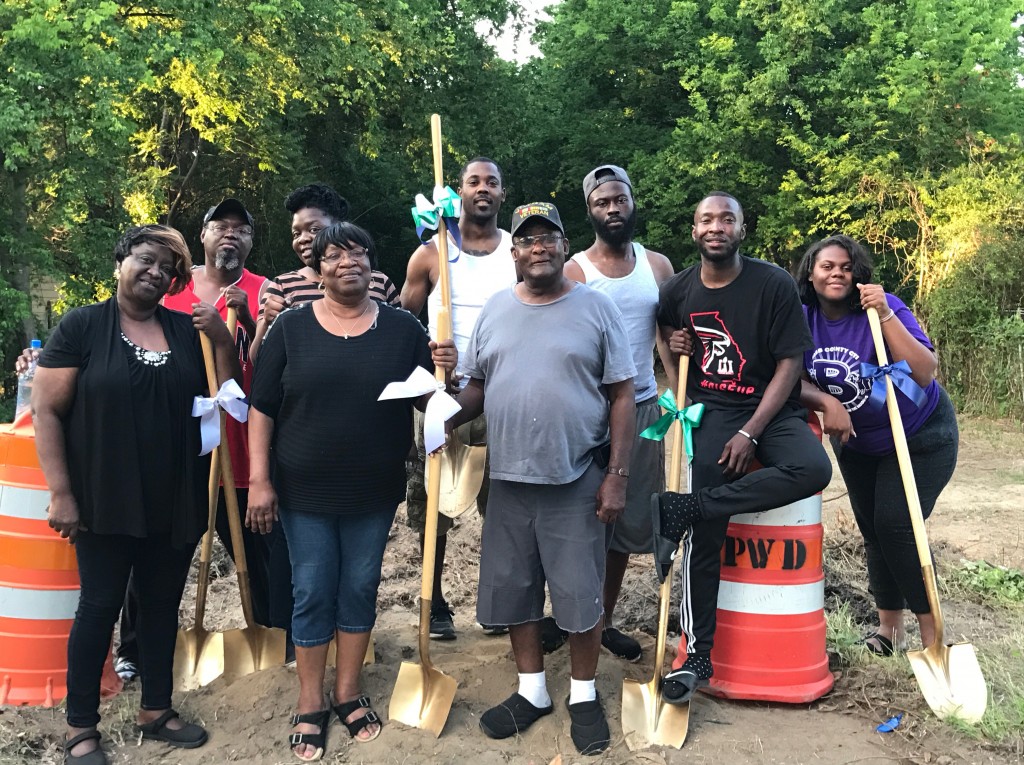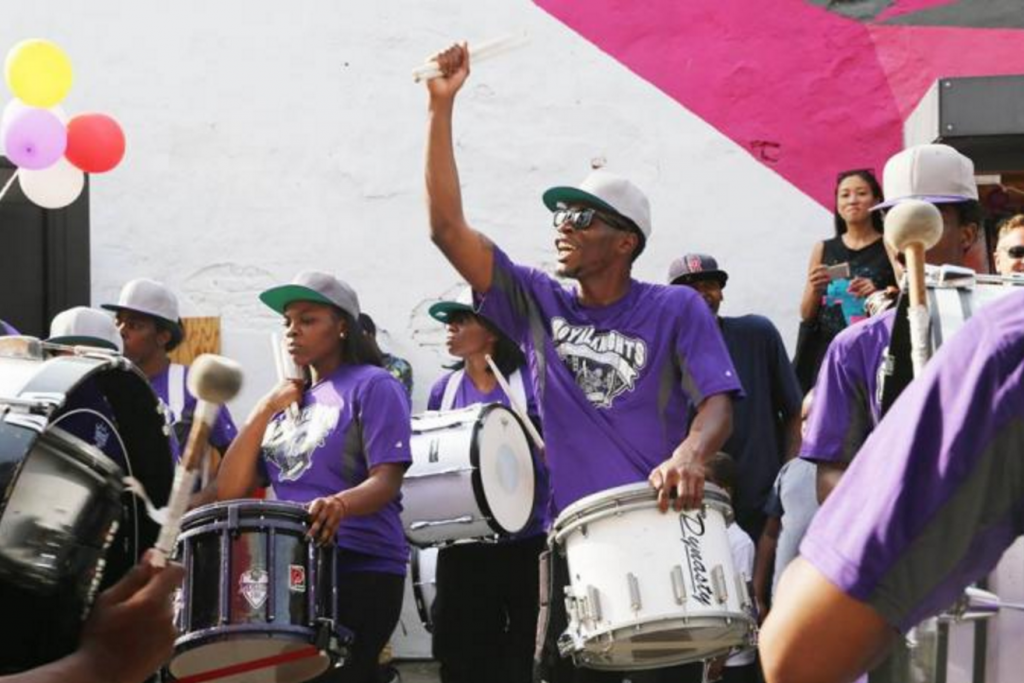ioby has worked with over 1,200 civic groups to raise more than $3.6 million dollars in citizen philanthropy for positive community projects. We enable and lift up leaders who are working to make their neighborhoods stronger and more sustainable. ioby leaders fund and create public art, gardens, small business cooperatives, bike infrastructure, public health campaigns, new classroom materials, and more. Often, a local government agency will assist members of the community as they set out to take on projects that align with a long-term plan related to sustainability, public health, or resilience.
[Image: Georgia’s first urban Agri-hood]
The importance of quick wins
What makes residents want to do this work? More often than not, they are motivated by the promise of a quick win.
Quick wins are powerful. Ideas like “Tactical Urbanism” and “Lighter, Quicker, Cheaper” stress the significance of small, short-term projects to moving the needle on important policy or planning issues. From a temporary installation of a crosswalk flag system to help families cross a busy intersection, to a pop-up bus shelter designed by commuters who want some shade and benches while they wait, these small projects with short fundraising timelines and rapid implementation schedules are changing public dialogue about what’s possible in our cities.
A successfully crowdfunded project helps residents see themselves not as passive stakeholders, but as active participants, in the future of their neighborhoods. Being part of a tangible, positive project, even if it’s a temporary pilot, shows residents that they are capable of leading change in their own community, and that their dreams of a sustainable, more resilient, beautiful, green, or equitable community are within reach. Maybe most importantly for the future of civic life in cities, quick wins inspire more would-be leaders to take the first step toward being more civically engaged.
The need for community trust
But what makes governments want to work with community leaders to get their ideas funded and resourced? A big factor is trust. It’s a tricky thing to measure, but the trust of residents is among a government’s most important assets. It’s a condition for a healthy democracy.
Over the past half-century, fewer and fewer citizens say they trust the government to do its job. In 1958, the Pew Research Center found that about 73% of citizens stated that they trust the government always or most of the time. Almost sixty years later, in 2017, that number is at about 20%. In cities, planning processes that are opaque and top-down not only breed distrust, but also create conflicts that undermine implementation and reduce the chances that a community will steward a civic good in the long term.
Distrust can be downright dangerous; when residents don’t trust their governments, they don’t feel compelled to heed emergency warnings or learn the roles and functions of institutions that are set up to help them in times of crisis — personal, financial, climate, or otherwise. This puts a considerable strain on government in times of citywide crisis or catastrophe, when virtually every resident of the city is suddenly looking to government for relief.
According to researchers at the University of Southern California, governments looking to build trust with residents need to work with citizen groups, be intentional about addressing specific problems in their delivery of services, and share power and authority with the residents they serve.
Employing these strategies, the New York City Department of Transportation (NYC DOT) worked with ioby in 2016 to build trusting relationships with residents in a neighborhood where residents have historically been disconnected from planning processes.
[Image: NYC DOT’s 2016 Livonia Avenue El-Space Challenge]
Using civic crowdfunding to move a plan into action
In their 2015 publication, Under the Elevated, NYC DOT and the Design Trust for Public Space set out to tackle a discrete problem: the city’s hundreds of miles of elevated infrastructure—highways, bridges, and rails—leave residual spaces below. Called “el-spaces,” these stretches of the public right-of-way are often dark, noisy, desolate, and stay unactivated. Dividing neighborhoods, they function as barriers in several of the city’s most heavily disinvested communities.
DOT recognized a particular urgency for el-space intervention in Brownsville, a majority Black neighborhood that has experienced decades of public and private disinvestment. They decided to focus their efforts in the short-term on improving public spaces along Livonia Avenue, where the subway tracks above cast a long shadow that bisects the neighborhood.
Rather than come to the neighborhood with a set of expectations, DOT set out to understand how Brownsville might address the problems associated with this el-space. DOT came to Brownsville with a three-part challenge: tell us what you think should happen under the tracks on Livonia, fundraise quickly for your project on ioby’s crowdfunding platform, and we’ll work in full and equal partnership with you to bring your idea to life.
DOT offered a three-to-one match, quadrupaling every dollar that each group raised. Groups raised close to $11,000 from over 70 donors from the neighborhood and beyond. The City matched with about $33,000 from the DOT, demonstrating that the City was ready to invest in the good ideas of people who live in Brownsville.
Through this partnership with ioby, DOT funded four community-led projects, built trusting and lasting relationships with local leaders in the area, and arrived at a better understanding of residents’ needs and priorities.
[Image: Make Music Brownsville]
Not just collaboration, co-production
Several studies have suggested that there’s a causal relationship between citizen participation in governance and an increase in trust in government (Brehm & Rahn 1997; Keele 2007; Tampubolon 2010). In other words, governments that involve residents in solving problems tend to have the trust of the people they serve.
But there’s more: involving citizens in decision-making at the local level helps governments achieve better outcomes, which, in turn, go a long way to reinforcing the trust of residents in government’s ability to make change. In other words, encouraging community participation initiates a virtuous cycle that bolsters trust and community resilience in the long term.
Over time, governments have looked more seriously at co-production as a powerful force for getting projects installed and properly maintained, and for building trust with their constituents. First coined in 1978 by the public administration theorist Elinor Ostrum, the idea of “co-production” describes a model in which both government and an affected community share responsibility for producing a public good or service. Because residents are involved in scoping, developing, and maintaining it, a coproduced public good is responsive and tailored neatly to the need of an affected community.
The community that crowdfunds together
While NYC DOT did not set out to explicitly tackle community resilience in their Under the Elevated work, they listened and invested in grassroots leadership in ways that made the community stronger and the government more able to respond to residents’ needs and wants.
ioby is still exploring the many ways in which our work makes vulnerable communities stronger and more able to recover from shocks and strains caused by disaster and hardship. But the successes of our partnerships with NYC DOT and other municipal government agencies nationwide suggest that civic crowdfunding based in a resident-centered approach to creating and funding neighborhood projects—can be a powerful way for the public sector to bolster trust, civic participation, and community resilience.
Governments concerned with improving a neighborhood’s ability to respond to an emergency must cultivate an active citizenry, demonstrate its trust in community leadership, and learn about the needs and concerns of residents. A civic crowdfunding partnership with ioby, coupled with a commitment to coproducing goods and services with residents, is a great place to start.
If you work in the public sector and are interested in discussing some ways to harness the power of civic crowdfunding for your city, town, or county, please go to ioby.org/gov and email David Weinberger, City Partnerships Director, at david@ioby.org.
References
Brehm J, Rahn W. (1997) “Individual-level evidence for the causes and consequences of social capital.” American Journal of Political Science. Vol.41:999- 1023.
Keele, L. (2007) “Social Capital and the Dynamics of Trust in Government”, American Journal of Political Science,Vol.51,No.2:241-257.
Ostrom, Elinor, and Roger B. Parks, Stephen L. Percy, and Gordon P. Whitaker. “The Public Service Production Process: A Framework for Analyzing Police Services.” Policy Studies Journal, vol. 7, no. s1, 1978, pp. 381-389. Wiley Online Library, onlinelibrary.wiley.com/doi/10.1111/j.1541-0072.1978.tb01782.x/full
Tampubolon, G. (2010) “Civic engagement and trust in Britain 2003-2004.” ISC Working Paper 2010-14, Manchester University.




